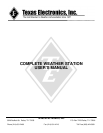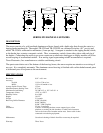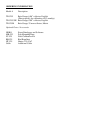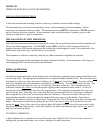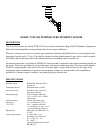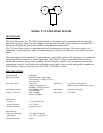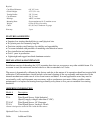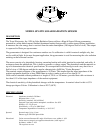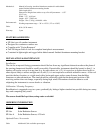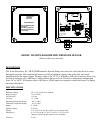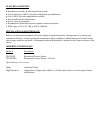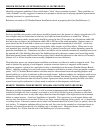
MODEL 525
TIPPING BUCKET RAIN GAUGE TRANSMITTER
INSTALLATION INSTRUCTIONS
A clear and unobstructed mounting location is necessary to obtain accurate rainfall readings.
This transmitter has provisions for mounting two ways, surface mounting and mast mounting. Surface
mounting is recommended where possible. The transmitter housing MUST be mounted in a LEVEL position
and in a location free from vibration. If mast mounted, make sure that the mast is properly guyed so that
vibration in high winds is kept to a minimum.
THE FOLLOWING IS VERY IMPORTANT:
After the final transmitter installation has been made, remove the top gold funnel portion of the transmitter and
observe the black tipping bucket. It should NOT (repeat NOT) be held in a dead center position by the
magnetic attraction of the bucket magnet and the hermetically sealed magnetic switch. Press either end of the
bucket down against the stop to be sure that it is not centered.
The transmitter to indicator connecting cable may be either shortened or lengthened as required.
The funnel and tipping bucket mechanism should be cleaned periodically. An accumulation of dirt, bugs, etc.
on the tipping bucket will adversely affect the calibration.
FIELD CALIBRATION
TR-525USW
Absolutely accurate calibration can be obtained only with laboratory equipment, but an approximate field check
can be easily made. The tipping bucket mechanism is a simple and highly reliable device. The transmitter must
be located in a clear area, away from trees, buildings, etc. It must also be mounted level. Accurate readings
will not be obtained unless the transmitter is mounted in a level position. The mechanism must be clean. Any
accumulation of foreign material, dust, etc. will alter the calibration of this unit. The transmitter must be
calibrated with the rate of flow of water through the tipping bucket mechanism under control. At least 36
seconds should be allowed to fill one side of the tipping bucket. This represents a maximum flow rate of on
inch of rain per hour. If the flow rate is increased, then the instrument will read low (if properly calibrated).
Decreasing the rate of flow will not materially affect the calibration. The reason for this is obvious if the
tipping bucket assembly is observed when the weight if this water starts to tip the bucket. Some time is
required for the bucket to tip (a few milliseconds). During the first 50% of this time, water flows into the empty
bucket. The amount of water flowing during the first 50% of the time is error, the faster the flow rate, the
greater the error. Now at flow rates of one inch per hour (100 bucket fillings) or less, the water actually drips
into the bucket rather than flowing. Under this condition, the bucket tips between drips, and no error water is
added to a full moving bucket.
TO CHECK CALIBRATION:
A field calibration kit is available from Texas Electronics, Inc. Model No. FC-525 is a kit that consists of a
holding tank, pre-measured beaker, two orifices, cleaning tools and instructions.



